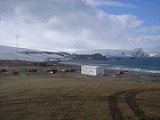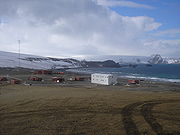
Artigas Base
Encyclopedia

Uruguay
Uruguay ,officially the Oriental Republic of Uruguay,sometimes the Eastern Republic of Uruguay; ) is a country in the southeastern part of South America. It is home to some 3.5 million people, of whom 1.8 million live in the capital Montevideo and its metropolitan area...
an scientific research station
Research station
A research station is a station built for the purpose of conducting scientific research. Research station sites might include outer space and oceans. Many nations have research stations in Antarctica; Showa Station, Halley and Troll are examples...
in Antarctica. It is only one of the 68 bases in Antarctica.
Organization
The Artigas Base depends on the Uruguayan Antarctic InstituteUruguayan Antarctic Institute
The Uruguayan Antarctic Institute is Uruguay's governmental agency to fund, organize, control and promote research on Antarctica according with the Antarctic Treaty System...
Plans & Operations Direction which is ruled by an Interministerial Council, with delegates of MoD, Foreign Affairs and ministry of Education and Culture.
Uruguay
Uruguay
Uruguay ,officially the Oriental Republic of Uruguay,sometimes the Eastern Republic of Uruguay; ) is a country in the southeastern part of South America. It is home to some 3.5 million people, of whom 1.8 million live in the capital Montevideo and its metropolitan area...
, a Consultative member of Antarctic Treaty since 7 October 1985, has a permanent, active and autonomous activity as a National Governmental Program in Antarctic. It comes to effect operating an all year round station in KGI, South Shetland, and seasonally at Antarctic Peninsula, and onboard its vessel, where performs scientific activity based on SCAR & Treaty needs and recommendations, supported by own logistic sea and air transport, and operating under COMNAP guidelines. Has delegates and members as full member of SCAR
Scar
Scars are areas of fibrous tissue that replace normal skin after injury. A scar results from the biological process of wound repair in the skin and other tissues of the body. Thus, scarring is a natural part of the healing process. With the exception of very minor lesions, every wound results in...
, SCAR-WG, COMNAP-SCALOP networks & WG
WG
WG may refer to:Places* West GermanyCulture* Wade-Giles , a romanization system for the Chinese language based on the form of Mandarin used in Beijing* W&G Records, an Australian recording company...
, CCALMR and ATCM.-
Since 1984 research has been performed in these areas:
Glaciology:
General Glaciology on KGI, South Shetlands, and Antarctic Peninsula, in various fields aiming to detect environmental changes due to anthropogenic activities and those related as response to climatic changes. This program is in scope of SCAR recommendations and is being carried out in cooperation with other nations operating in Antarctica(KORDI)
Atmospheric sciences
Calibration of effects of the atmosphere on metals commonly used in the Antarctic
Mossbauer spectroscopy to identify atmospheric corrosion products
Installation and operation of an ionospheric laboratory at Artigas, the Uruguayan year-round research station on King George Island
Ocean sciences
Comparative studies of physical and chemical variables in coastal waters of Fildes Bay
Observations of the Antarctic Polar Front (Antarctic Convergence)
Marine meteorology of Drake passage, according to SCAR and Treaty objectives.
Earth sciences
Satellite geodesy applications for SCAR_EPOCH & GIANT Program
Life sciences
Medical research
Antarctic krill (Euphausia superba) vascular and lipid characteristics
Modification of collagen disease and atheroma in rabbits by adding krill to their diet
Ornithological observations in Fildes Peninsula (King George Island), South Bay (Livingston Island), and Harmony Point (Nelson Island), South Shetland Islands
Behavioral studies in a penguin colony in the South Shetland Islands
Logistics:
Are provided by the National Defense Ministry (of which the Uruguayan Antarctic Institute is a part) and the armed forces (army, navy, and air force), which also contribute to scientific programs.
Transport methods include Hercules C-130B airplanes, Bell 212 helicopters, Navy Ships and other seaborne units, amphibious vehicles, and various land vehicles.
Uruguayan Antarctic research is generally proportional to overall national efforts, although there is a special emphasis on life sciences and those related to changes in the environment.
Uruguay is particularly mindful of environmental matters and abides by all agreements and treaties pertinent to the Antarctic, so develops continuous environment monitoring programs complementing the impact assessments of its activities.
Location of base
- South Shetlands, KGI, Fildes Peninsula
- Lat: 62°11'04 Long: 58° 54 “
- 17 mts above sea level
- Ice free surface
- 100 meters from the Antarctic coastline
- Bellingshausen St. nearest station
- Usuahia (1000 km) nearest port
Additional notes
Around 10 scientists in summer, 6 crew for helicopter, 3-5 for maintenance, 4 servicemen.Science activities
The following science activities are carried out at Base Cientifica Antárctica Artigas:- Environmental monitoring (since 1998)
- Geodesy/mapping (since 1986)
- Glaciology - continental (since 1991)
- Human biology (since 1985)
- Ionospheric/auroral observations (since 1992)
- Meteorological observations (since 1984)
- Stratospheric ozone monitoring (since 1998)
- Tide measurement (since 1989)
Power and fuel supply
- 220 V 60 kHz power supply
- 375 kVA power generation capacity
- 3 generators
- Generators fuelled with Antarctic Gas Oil
- 160.000 lts of fuel used annually
- none wind generator
Medical facilities
- Base Cientifica Antárctica Artigas has the following medical facilities:
- 30 sqm medical suite
- 1 doctor
- 0 paramedic(s)
- 2 beds for patients
- MEDEVAC & Fire Plan updated and exercised
Logistic support
- Ice
- Ice breakout: October
- Fast ice formation: late May
- Shipping
- 1 ship visit(s) per season
- 1 resupply visit(s) per season (in January)
- 300 mts from station to anchorage
- 30 mts deep anchorage
- Air transport
- 7 intercontinental flights per season
- Aircraft used: Hercules C-130
- Light aircraft/helicopter available December–March
- Types used: Bell 212
- 1 concrete & 1 rock for Helicopter airstrip surface
- at base from station to airstrip
- Other support transport
- Tracked personnel carriers: 2x Hagglunds
- Snowmobiles: 1x snowmobile
- Rough terrain quads/tricycles: 1xquad
- Outboard watercraft: 2x zodiacs
- Trucks
- 1xIFA
- Tractors, loaders, excavators
- Wheeled tractor(s): 1 massey ferguson
External links
Uruguayan Antarctic Institute Antarkos 23, the 2007 Artigas Base Crew- OMNI article: 11th Sep 2007, eclipse of sun views from Artigas base
- Antarctica Trip, a Cristy Trembly report on her visit to Artigas and ECARE bases in 2000.
- Antarctica Marathon 2007: William Smith blog´s post including Artigas Base views and comments
- COMNAP Antarctic Facilities
- COMNAP Antarctic Facilities Map

